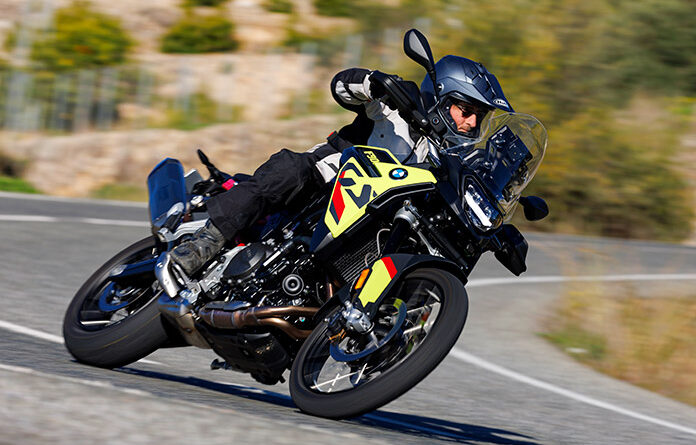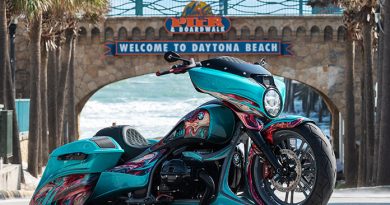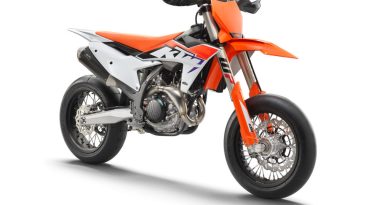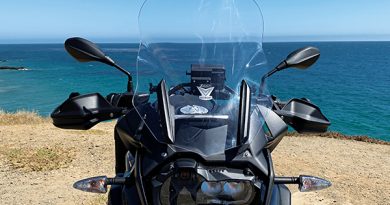2024 BMW F 900 GS Review | First Ride
The adventure-bike market is the hottest segment in motorcycling, with new models being introduced every year. The middleweight ADV category has been dominated by Yamaha’s Ténéré 700 and KTM’s various 790/890 Adventure models, but new or updated models from Aprilia (Tuareg 660), Honda (XL750 Transalp), Suzuki (V-Strom 800), and Triumph (Tiger 900) are enticing riders to reevaluate their options.
Meanwhile, BMW has been selling mid-weight ADVs for almost two decades. The F 800 GS was introduced in 2009 but was often overshadowed by its boxer-powered bigger brothers, culminating in the recent glowingly reviewed R 1300 GS.
Related: 2024 BMW R 1300 GS Review | First Ride
For 2024, BMW expects the new F 900 GS to draw a brighter light to its reinvigorated middleweight platform. After testing it on roads and on dirt, we can safely say this is the best parallel-Twin adventure bike ever offered from the German company.
What’s New?
Quite a lot, actually. The F 850’s motor has been punched out to 895cc and now delivers 105 hp, up 10 ponies from the older mill. The former cast pistons have been cast aside for forged pistons that are 2mm larger than before.
Additionally, 31 lb of weight has been shaved off for this new iteration, now scaling in at 483 lb with its 3.8-gallon tank full. The fuel cell swaps steel for plastic to pare down about 10 lb, and a new Akrapovič muffler trims 3.7 lb. A lower tailsection trims another 5 lb, while the trellis steel frame remains unchanged.
The F 900 GS also benefits from a lower and more svelte profile that eliminates much of the bulkiness of its F 850 predecessor. The bike not only looks smaller, its design language looks fresh and contemporary, aided by full LED lighting and rear turnsignals that serve double duty as brake lights.
The F 900 GS is well-equipped in its base form, with a starting price of $13,495. Standard equipment includes a six-axis IMU and two riding modes (Rain and Road), plus ABS Pro and Dynamic Traction Control. A vibrant 6.5-inch TFT display with smartphone connectivity is part of the package, as are hand guards, heated grips, an adjustable aluminum shift lever, and self-canceling turnsignals.
The 900’s suspension has been upgraded, now with a fully adjustable 43mm Showa fork holding a 21-inch front wheel. The rear damper includes adjustable preload and rebound damping to control bumps acting on a slightly lighter aluminum swingarm. Suspension travel is a generous 9.1 inches in front and 8.5 at the rear, resulting in a 34.3-inch seat height. An accessory low seat brings height down to 32.9 inches.
BMW offers a similar but lower-spec (and more street-oriented) F 800 GS for only $10,495, with its 895cc motor downgraded to 87 hp, but it wasn’t available for testing. Also not tested was the Adventure version of the F 900 GS, which includes a 6.1-gallon fuel tank, Dynamic ESA, a luggage rack, and an aluminum bash plate. It has a starting price of $14,890.
Options Temptations
As is typical for BMW, there are a plethora of options for the F 900 GS. Ride Modes Pro supplies access to Dynamic, Enduro, and Enduro Pro rides modes, as well as Engine Drag Torque Control, which varies the amount of engine braking.
Then there’s the Premium Package that includes Ride Modes Pro, along with keyless ignition, an up/down quickshifter, tire-pressure monitoring, cruise control, and the long-lasting M Endurance Chain. It costs an extra $1,750.
Riders who enjoy traipsing on dirt roads will be interested in the $1,495 Enduro Pro package, which includes Ride Modes Pro, fully adjustable suspension, the M Endurance chain, and a taller handlebar that is more comfortable for stand-up riding.
Other optional equipment includes protective bars, windscreens of various sizes, higher or lower seats, Intelligent Emergency Call, and a full complement of luggage options.
GS en España
BMW invited us to Málaga, Spain, to sample the F 900 GS, and in a coincidental twist, we stayed at the same hotel as during Triumph’s Tiger 900 launch just two months prior! It was illuminating to test these 900cc ADVs in the same area of southeastern Spain.
We first straddled Sao Paulo Yellow versions of the F 900 GS for a morning ride on some of Spain’s countless twisty roads. This “Passion” style colorway adds $275 to the price of the base GS, which has a black colorway. Our bikes had other options that raised their MSRP to $16,215.
The F 900’s parallel-Twin motor emits a rumbly note through its new Akrapovič muffler. Its crankshaft journals are offset by 90 degrees to create a 270/450-degree firing interval that sounds a lot like a 90-degree V-Twin. A pair of counterbalancers (one in front of and one behind the crankshaft) minimize objectionable vibrations.
Responses from this invigorated mill are much punchier than before. It pulls cleanly from as low as 2,000 rpm and builds to a meaty midrange that thrusts the Beemer forward with satisfying alacrity, aided by lower final-drive gearing. Torque swells in the 6,000-rpm range to its 68.6 lb-ft peak at 6,750 rpm then yanks harder on the way to its 105-hp zenith at 8,500 rpm.
For comparison, Triumph’s upgraded 888cc three-cylinder motor in the Tiger 900 cranks out 106.5 hp, while the output of KTM’s respected 890 parallel-Twin produces 103.6 ponies. It’s remarkable how closely the engines of these middleweight ADVs match up.
My 30-inch inseam was a little intimidated by the relatively tall 34.3-inch seat height, but it wasn’t a problem after my weight was aboard and the suspension compressed. The bike proved to be adept at navigating city streets on the way to mountain roads, with a light clutch pull and the assistance of the quickshifter fitted to our bikes.
The cockpit of the GS is pleasing to the eye, with an attractive 6.5-inch color TFT display front and center. It includes smartphone connectivity and can easily be navigated with BMW’s innovative Multicontroller wheel on the left grip. A 12-volt socket and a USB port ensure your devices will be charged while out on the road.
Riding on a highway section revealed a foible in the GS. Unlike the Tiger’s, the BMW’s windscreen isn’t adjustable. The accessory screen, which is 2 inches taller than stock, fitted to our test bikes induced buffeting on my helmet at higher speeds, and the lack of adjustability forced me to endure it. Any bike intended for travel should have a simple system for on-the-fly windscreen adjustments.
The GS proved to be remarkably adroit on the twisty sections of our ride. Turn-in response isn’t quite as brisk as on the Tiger due to the GS’s more relaxed steering geometry, with a 28-degree rake and 4.7 inches of trail, but the GS’s weight loss and its wide handlebar helps it carve corners adeptly. The 21-inch front tire (Bridgestone Battlax Adventure A41) slightly diminishes sporty front-end feedback, as is always the case, but not enough to inhibit acute lean angles. For what it’s worth, I was able to drag footpegs on the Tiger Rally Pro, but I didn’t on the BMW.
The long-travel suspension of the GS proved to be plush over various road surfaces, but several riders noted the rebound damping of the shock felt too loose, with the rear bouncing up excessively after hitting bumps. At a coffee stop, we all dialled in additional rebound damping on the shock, and the revised settings offered much better control. The shock’s spring preload is adjustable, but its compression-damping circuit is not.
The fully adjustable inverted fork performed well, but less impressive are the GS’s brakes. Up front are Brembo calipers, but they’re low-spec 2-piston units rather than 4-piston clampers that are typically employed on bikes in this price range. They offer plenty enough power to adequately slow the bike, sure, but they’re not up to the high standards of the class. Cornering ABS is a welcome safety feature that is included as standard equipment.
Gear Up
Helmet: HJC DS-X1
Jacket: Rev’It Neptune 2 GTX
Pants: Klim Latitude
Gloves: Rev’It Dirt 3
Boots: Alpinestars Toucan
There were several opportunities on our ride to twist the throttle wide open and stretch speed limits. The newfound punchiness of the motor again impressed the seat of my pants, pulling hard enough to make me feel that a 1,200-plus-cc engine might be overkill for an ADV. Clutchless upshifts were clicked off smoothly, but snicking into lower gears without using the clutch was harsher than with the Tiger’s faultless transmission.
We were having so much fun unwinding Spain’s sinuous backroads on the GS that we didn’t want to bother stopping for lunch.
Dirty Work
After some delicious tapas, we climbed aboard bikes in the GS Trophy colorway with BMW’s red and blue colors atop a white base coat, sure to be the likely choice for Beemerphiles. These bikes were fitted with knobbier Metzeler Karoo 4 tires better suited for the off-roading adventures in front of us. BMW’s cross-spoke wheels allow tubeless tires.
Like a well-engineered ADV should, the F 900 GS seems to shed weight when ridden off-road. Simply point it in the right direction and keep the throttle open, and it tractors up nearly any obstacle. While most of our off-roading was on non-technical terrain, we came across a few technical sections with rocks and hills that gave the GS a good test. Its suspension performed without complaint from the bike or its rider, and its punched-out motor again proved its worthiness in ADV situations, able to be lugged low in its powerband where optimum traction is delivered.
I spent the entire afternoon with the bike in its Enduro Pro mode, which disables ABS at the rear tire and loosens the limits of traction control. Eventually, I switched off traction control completely, as I preferred my right hand to be fully in charge of managing traction.
The brakes that felt underwhelming on the street were nearly perfect in the dirt. They weren’t grabby or overly sensitive like some high-powered braking systems, shedding speed in precise and easy to control amounts. However, I felt the front ABS kick in on a rocky, technical downhill section, an unnerving situation. A ride mode with the name “Pro” in it should have looser parameters for ABS intervention.
On the way back into town, I was pleased that the standard-height windscreen eliminated the buffeting condition I felt at higher speeds with the taller screen. The narrow seat, however, was less pleasing, and I’d consider sourcing a different saddle if I was piling on hundreds of miles. On the plus side, a generous amount of steering lock makes the GS easy to maneuver in tight spaces, whether it’s dodging trees in a forest or Teslas in a crowded parking lot.
Best GS Yet?
Well, that would depend on what you want from a GS. The new R 1300 GS is magnificent and has a broader range of capabilities along with a more powerful engine. But after a short spin on a 1300 during a transit stage of our off-road ride, I preferred the 900’s relative agility and the way its rear tire grabbed for traction relative to the 1300’s shaft-drive arrangement.
The F 900 GS faces stiff competition in the marketplace. The Tiger 900 Rally Pro is in some respects more appealing than the Beemer, with its engaging 3-cylinder engine, Brembo Stylema brakes, and adjustable windscreen. Combined with a larger fuel tank and a comfier stock seat, the Tiger is a worthy adversary.
But the BMW F 900 GS is appealing in its own right, flying the BMW flag high for aficionados of the brand. The Beemer is built in Germany, the land of technocrats and precision engineering, while the Tiger is produced in Thailand, for whatever that’s worth to ya.
For my money, on a per-dollar value, I believe the BMW F 900 GS is the best GS yet.
2024 BMW F 900 GS Specs
Base Price: $13,495
Warranty: 2 yrs., unltd. miles
Website: BMWmotorcycles.com
ENGINE
Type: Liquid-cooled, parallel-Twin, DOHC w/ 4 valves per cyl.
Displacement: 895cc
Bore x Stroke: 86.0 x 77.0mm
Horsepower: 105 hp @ 8,500 rpm (factory claim)
Torque: 68.6 lb-ft @ 6,750 rpm (factory claim)
Compression Ratio: 13.1:1
Valve Insp. Interval: 12,000 miles
Fuel Delivery: EFI w/ throttle-by-wire, 48mm throttle bodies
Transmission: 6-speed, cable-actuated slip/assist wet clutch
Final Drive: Chain
CHASSIS
Frame: Tubular-steel trellis frame & subframe, aluminum swingarm
Wheelbase: 62.6 in.
Rake/Trail: 28.0 degrees/4.7 in.
Seat Height: 34.3 in.
Suspension, Front: 43mm inverted fork, fully adj., 9.1 in. travel
Rear: Single linkage shock, w/ adj. spring preload & rebound, 8.5 in. travel
Brakes, Front: Dual 305mm discs w/ 2-piston axial calipers & cornering ABS
Rear: Single 265mm disc w/ 1-piston caliper & cornering ABS
Wheels, Front: Cross-spoke w/ aluminum rims, 2.15 x 21
Rear: Cross-spoke w/ aluminum rims, 4.25 x 17
Tires, Front: 90/90-21
Rear: 150/70-17
Wet Weight: 483 lb
Fuel Capacity: 3.8 gal.
The post 2024 BMW F 900 GS Review | First Ride appeared first on Rider Magazine.




